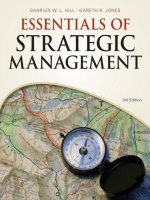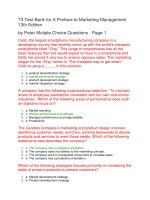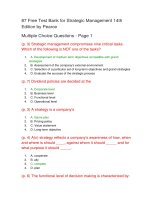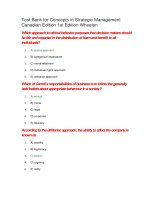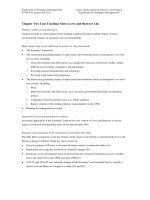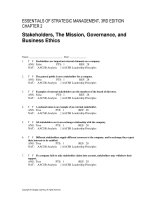Fred r david – strategic management, 13th edition ch11
Bạn đang xem bản rút gọn của tài liệu. Xem và tải ngay bản đầy đủ của tài liệu tại đây (276.72 KB, 451 trang )
Exam
Name___________________________________
TRUE/FALSE. Write 'T' if the statement is true and 'F' if the statement is false.
1)
Most strategists believe that an organization's wellbeing depends on evaluation of the strategicmanagement process.
1)
_______
2)
Adequate, timely feedback is important to effective strategy evaluation.
2)
_______
3)
Too much emphasis on evaluating strategies may be expensive and counterproductive.
3)
_______
4)
Strategy evaluation should have a long-run focus and avoid a short-run focus.
4)
_______
5)
According to Richard Rumelt, consonance and consistency are based on a firm's external assessment.
5)
_______
6)
According to Rumelt, consistency and feasibility are largely based on a firm's internal assessment.
6)
_______
7)
Consistency, distinctiveness, advantage and feasibility are Richard Rumelt's four criteria for evaluating a
strategy.
7)
_______
8)
Strategy evaluation is becoming increasingly easier with the passage of time, given the technological
advances.
8)
_______
9)
The decreasing time span for which planning can be done with any degree of certainty is a reason why
strategy evaluation is more difficult today.
9)
_______
10)
Strategies may be inconsistent if policy problems and issues continue to be brought to the top for
resolution.
10)
______
11)
Competitive advantages are normally the result of superiority in one of three areas feasibility, consistency,
or consonance.
11)
______
12)
Regardless of the size of the organization, a certain amount of management by wandering around at all
levels is essential to effective strategy evaluation.
12)
______
13)
Because large companies have more at stake, it is more important for them to conduct strategy evaluation
than it is for small companies.
13)
______
14)
The end of the fiscal year is the best time to do a strategy evaluation.
14)
______
15)
Changes in the organization's management, marketing, finance, R&D and CIS strengths and weaknesses
should all be the focus of a revised EFE matrix in strategy evaluation.
15)
______
16)
In strategy evaluation, a revised IFE matrix should indicate how effective a firm's strategies have been in
response to key opportunities and threats.
16)
______
17)
Strengths, weaknesses, opportunities and threats should continually be monitored for change, because it is
less a question of whether these factors will change but rather when they will change and in what ways.
17)
______
18)
When taking corrective action, you need to compare expected results to actual results.
18)
______
19)
Criteria for evaluating strategies should be measurable and easily verifiable.
19)
______
20)
Specific financial ratios are rarely used criteria to evaluate strategies.
20)
______
21)
Measuring organizational performance includes comparing expected results to actual results, investigating
deviations from plans, evaluating individual performance and examining progress being made toward
meeting stated objectives.
21)
______
22)
Intuitive judgments are almost always involved in deriving quantitative criteria.
22)
______
23)
Most quantitative evaluation criteria are geared to long-term objectives rather than annual objectives.
23)
______
24)
Measuring organizational performance requires making changes to reposition a firm competitively for the
future.
24)
______
25)
